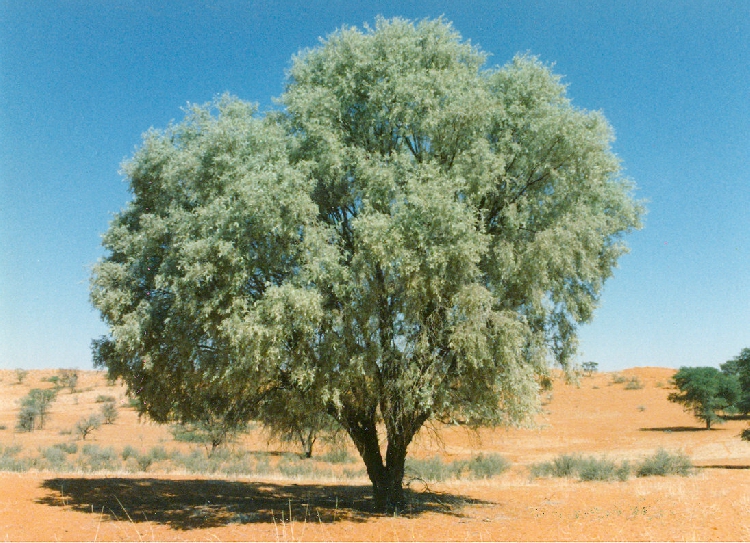bull; LUISE HOFFMANNTHIS tree is confined to the deep red sands south east of Rehoboth up to the Orange River as well as the adjoining Kalahari regions of Botswana and South Africa.
Its feathery leaves are so finely divided that they almost seem to be once compound only, while in fact they are twice compound like the leaves of acacias in general.
They are densely covered with fine grey hairs giving the entire tree a distinctly grey appearance to which the common name of course refers. A few such trees are found on deep, wind blown sand south of Maltah ouml;he.
Names: G. Fahlkameldorn; A. vaalkameeldoring, kha boom; N/D. !kh acirc;s. The botanical name haematoxylon means ‘blood red wood’ and refers to the deep red heartwood of this tree.
The grey camel thorn generally is a tree of up to 8 m with somewhat drooping branches. It also occurs as a shrub or shrubby tree of similar height. The trunk is grey brown and younger branches are covered in fine grey hairs.
Dropping its leaves in September, the grey camel thorn tree immediately produces new foliage. The leaves bear 8 -22 pinnae pairs, each pinna with 15 22 leaflet pairs, arranged so densely as to appear undivided.
The paired white thorns are relatively slender and may reach a length of up to 6 cm. Young thorns are pale brown and slightly downy. Golden yellow, ball shaped flowers appear from November to March.
The cylindrical pods can be up to 14 cm long. They are somewhat sickle shaped, slightly constricted between the seeds and have a grey velvety covering.
This graceful small tree with its dark trunk and its grey foliage forms a lovely contrast to the red sands of the Kalahari and the blue sky overhead.
It is very difficult to grow without deep sand and outside its semi desert environment. Reportedly the red heartwood is particularly suited to making wind instruments. The tree produces large quantities of an edible gum and the fruit wall of the pod is also edible. The pods are relished by livestock and game.
In areas where the grey camel thorn tree grows together with the true camel thorn (Acacia erioloba) the two species may cross breed. These hybrids are similar to camel thorn trees in size, growth form and shape of pods, but their leaves are finely divided and covered in soft grey hairs like those of the grey camel thorn tree.
Like the true camel thorn tree, the grey camel thorn tree is protected by forestry legislation.
Other trees typical of the Kalahari are the true camel thorn tree, so emblematic of this region, and the worm cure albizia or Aruboom (Albizia anthelmintica) whose bark is known as treatment for intestinal parasites in humans and livestock all over Africa.
The almost evergreen shepherd’s tree (Boscia albitrunca) provides very nutritious foliage and welcome shade.
Large stretches of the valley of the Auob River are choked by the encroaching Prosopis tree from Mexico, which crowds out the indigenous camel thorn trees.
Stay informed with The Namibian – your source for credible journalism. Get in-depth reporting and opinions for
only N$85 a month. Invest in journalism, invest in democracy –
Subscribe Now!






